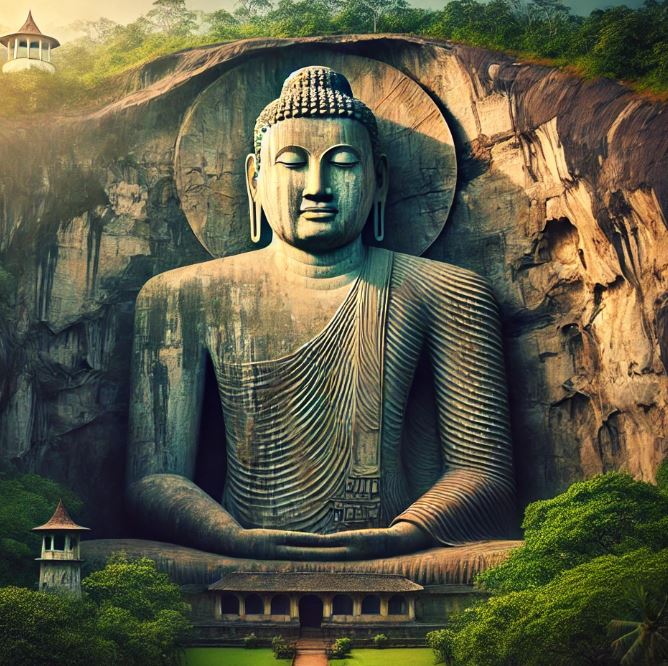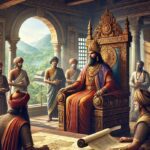The Awe-Inspiring Awkana Buddha: A Timeless Symbol of Devotion and Mastery in Sri Lanka – By Bhanuka – eLanka

Tucked away in the lush greenery of the North Central Province of Sri Lanka, near the ancient city of Anuradhapura, stands one of the most remarkable and awe-inspiring monuments of Buddhist art: the Awkana Buddha statue. This colossal statue, carved out of a single granite rock face during the 5th century, is a testament to the artistic mastery and deep spiritual devotion of ancient Sri Lankan craftsmen. The Awkana Buddha is not just a symbol of religious significance; it is a living testament to the island’s rich cultural heritage and the enduring influence of Buddhism in Sri Lanka.
The story of the Awkana Buddha is one of faith, perseverance, and the unyielding human spirit. It is a tale that transcends time, touching the hearts of those who stand before this majestic figure, who gaze upon its serene face, and who feel the deep spiritual energy that radiates from its presence. This statue, over 12 meters (39 feet) tall, stands as a sentinel of peace, watching over the land, and serving as a beacon of hope and enlightenment for all who visit.
The Historical Context of the Awkana Buddha
The Awkana Buddha statue was commissioned during the reign of King Dhatusena, a ruler known for his patronage of Buddhism and his dedication to the development of religious monuments across Sri Lanka. The statue is believed to have been carved between the 5th and 7th centuries AD, during a time when Sri Lanka was a thriving center of Theravada Buddhism. The decision to carve such a massive statue out of solid rock reflects the depth of devotion that the people of that era had for the Buddha and his teachings.
The statue is located near the Kala Wewa reservoir, an ancient irrigation tank also built by King Dhatusena, which underscores the king’s vision of integrating spiritual and practical needs. The proximity of the statue to the reservoir symbolizes the harmony between spirituality and daily life, a theme that is central to Buddhist philosophy.
Artistic Mastery and Symbolism
The Awkana Buddha is a masterpiece of ancient Sri Lankan sculpture. Standing at an impressive height, the statue is carved in the Abhaya Mudra, a gesture of fearlessness and protection. This mudra is symbolic of the Buddha’s assurance to his followers that they need not fear anything as long as they walk the path of righteousness. The statue’s right hand is raised to shoulder height with the palm facing outwards, while the left hand rests at the side, symbolizing the Buddha’s readiness to protect and guide.
What makes the Awkana Buddha particularly awe-inspiring is the level of detail and precision achieved by the ancient craftsmen. The folds of the robe are carved with such finesse that they appear almost lifelike, flowing gracefully over the Buddha’s body. The facial expression of the statue is one of profound serenity and compassion, embodying the Buddha’s infinite wisdom and love for all beings. The statue’s slightly bent knees suggest a readiness to step forward, symbolizing the Buddha’s active engagement in guiding his followers toward enlightenment.
The Spiritual Significance of the Awkana Buddha
For centuries, the Awkana Buddha has been a place of pilgrimage for Buddhists from all over Sri Lanka and beyond. It is not just the physical grandeur of the statue that draws people, but the deep spiritual energy that it emanates. The statue is believed to possess protective powers, and many come to offer prayers and seek blessings for protection, peace, and prosperity.
The Awkana Buddha stands as a symbol of the Buddha’s enduring presence in the world, a reminder that his teachings are timeless and continue to guide people toward the path of enlightenment. The statue’s location, surrounded by nature, further enhances its spiritual ambiance. The serene environment allows visitors to meditate and reflect, fostering a deep connection with the Buddha’s teachings.
Preservation and Challenges
Despite its historical and spiritual significance, the Awkana Buddha has faced numerous challenges over the centuries. Natural weathering, environmental changes, and human interference have all threatened the statue’s preservation. However, various conservation efforts have been undertaken to protect this invaluable heritage site. These efforts include regular maintenance, structural reinforcements, and protective measures to shield the statue from environmental damage.
The Sri Lankan government, along with various cultural and religious organizations, has been actively involved in preserving the Awkana Buddha. These efforts are crucial not only for the preservation of the statue itself but also for the preservation of the cultural and spiritual heritage of Sri Lanka.
The Impact of the Awkana Buddha on Modern Sri Lanka
In modern times, the Awkana Buddha continues to be a source of inspiration and pride for the people of Sri Lanka. It serves as a powerful reminder of the island’s rich cultural history and the enduring influence of Buddhism. The statue attracts not only pilgrims but also tourists from around the world, contributing to the country’s cultural tourism industry.
Moreover, the Awkana Buddha has also become a symbol of national identity and resilience. In a country that has faced numerous challenges, including a prolonged civil war, the statue stands as a testament to the enduring spirit of the Sri Lankan people. It is a symbol of peace, unity, and the ability to rise above adversity.
Personal Reflections: A Pilgrimage to Awkana
Visiting the Awkana Buddha is more than just a journey to a historical site; it is a deeply personal and spiritual experience. Standing before the statue, one cannot help but feel a sense of awe and reverence. The sheer scale of the statue, combined with its serene expression, evokes a feeling of peace and calm that is difficult to describe. Many visitors have reported feeling a profound connection to the Buddha and his teachings while standing in the presence of the Awkana statue.
For Buddhists, the pilgrimage to Awkana is a journey of faith and devotion. It is an opportunity to reaffirm their commitment to the Buddha’s teachings and to seek his guidance in their lives. For others, regardless of their religious beliefs, the visit to Awkana is a chance to connect with a piece of history and to appreciate the artistic and cultural achievements of ancient Sri Lanka.
Conclusion
The Awkana Buddha is more than just a statue; it is a symbol of Sri Lanka’s rich cultural and spiritual heritage. It is a testament to the artistic mastery and deep devotion of the people who created it, and it continues to inspire and uplift those who visit it. The statue stands as a reminder of the timelessness of the Buddha’s teachings and the enduring influence of Buddhism in Sri Lanka.
In a world that is often filled with turmoil and uncertainty, the Awkana Buddha offers a message of peace, protection, and hope. It is a beacon of light that continues to guide people toward the path of righteousness and enlightenment. As we continue to preserve and protect this invaluable heritage site, we ensure that future generations can also experience the awe and reverence that the Awkana Buddha inspires.























